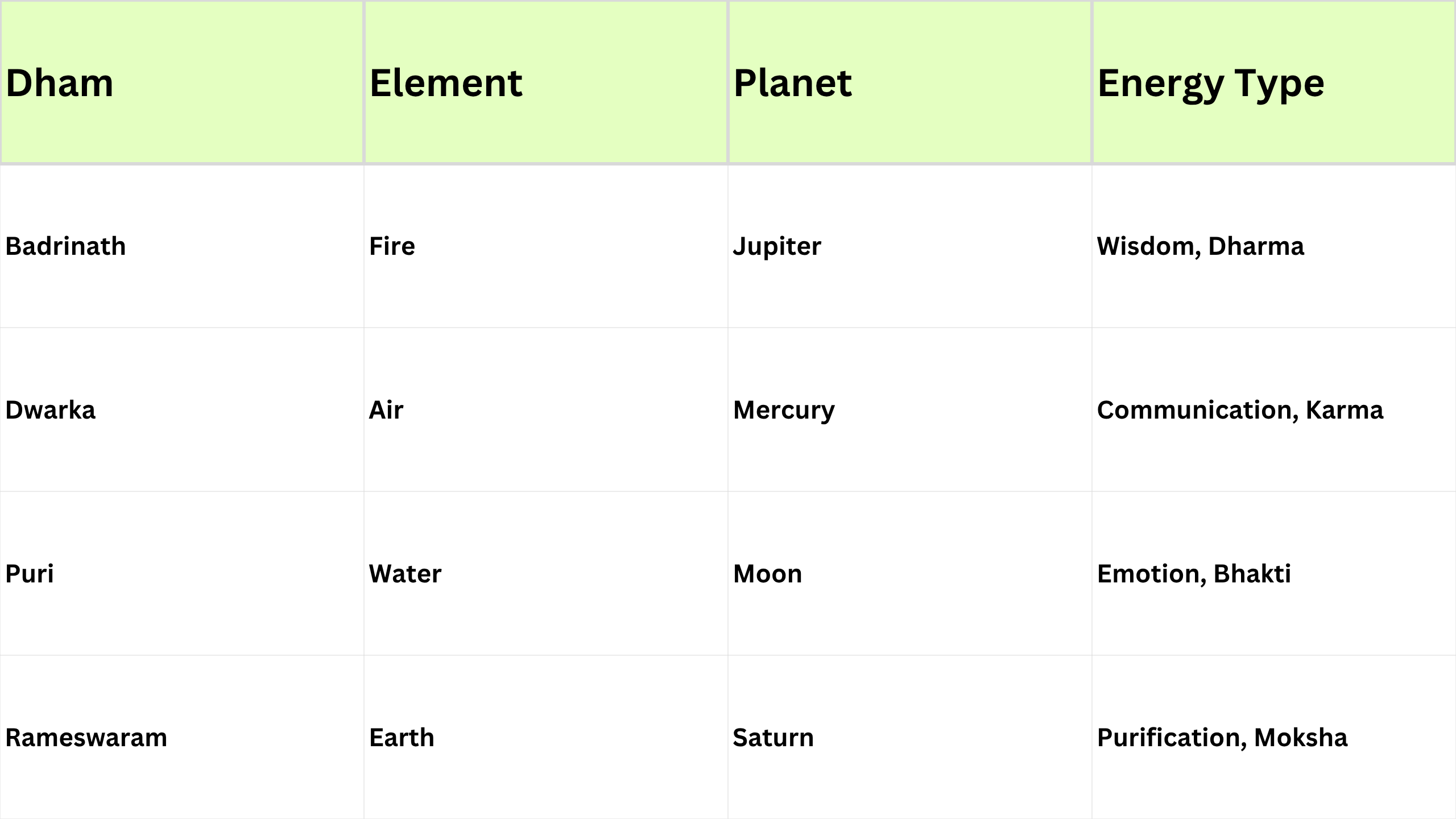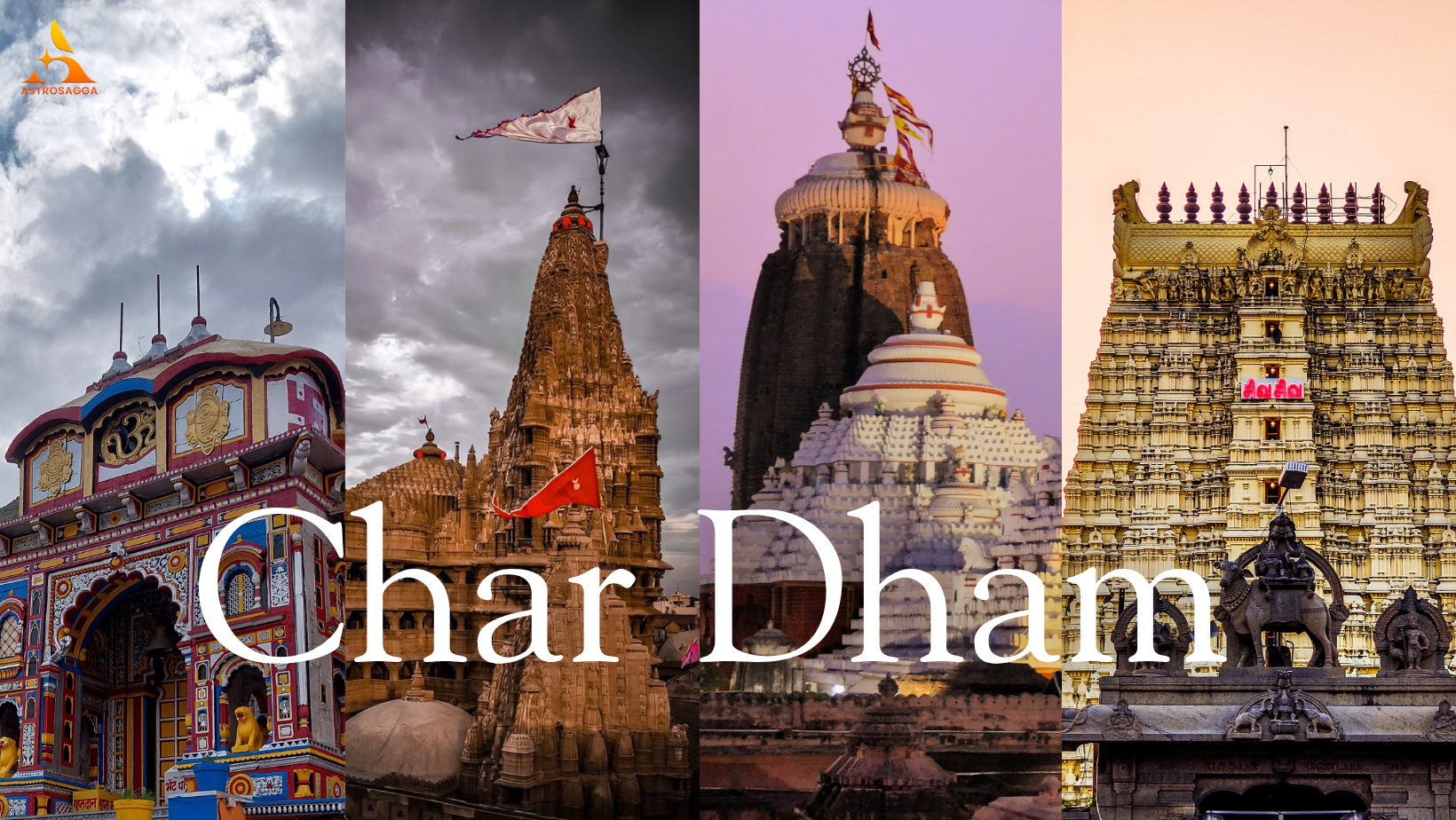Introduction to Char Dham Yatra
The Char Dham Yatra is one of the most sacred pilgrimages in Hinduism. The word “Char Dham” translates to “four abodes” — spiritual destinations believed to wash away sins and grant moksha (liberation). It’s not just a journey; it’s a spiritual transformation that connects the individual soul to the divine energy of the universe.
The journey includes four key pilgrimage sites: Badrinath, Dwarka, Puri, and Rameswaram, strategically located in the four directions of India — North, West, East, and South, respectively.
Let’s explore the 4 dham name and place, their divine significance, their link with Vedic astrology, and the deeper purpose behind undertaking this sacred yatra.
What Are the 4 Dham Names and Places?
Here are the 4 dham names along with their geographical and spiritual locations:
Badrinath (North India)
Location: Uttarakhand
Presiding Deity: Lord Vishnu (Badri Narayan)
State: Uttarakhand, near the Alaknanda River
Dwarka (West India)
Location: Gujarat
Presiding Deity: Lord Krishna
State: Gujarat, on the coast of the Arabian Sea
Puri (East India)
Location: Odisha
Presiding Deity: Lord Jagannath (form of Krishna/Vishnu)
State: Odisha, near the Bay of Bengal
Rameswaram (South India)
Location: Tamil Nadu
Presiding Deity: Lord Shiva (Ramanathaswamy)
State: Tamil Nadu, on Pamban Island in the Indian Ocean
Read Also - Tarot vs. Astrology: Which Is More Accurate?
Why These 4 Dhams? Purpose Behind Char Dham Yatra
The Char Dham Yatra is not just a religious tradition—it is a deep spiritual roadmap designed to elevate the soul. The purpose of undertaking this sacred yatra is to go beyond the physical realm and reach a state of inner purification, karmic balance, and ultimately, liberation (moksha). Each of the four dhams plays a unique role in this divine journey.
1. Badrinath – The Path of Spiritual Awakening (North)
Deity: Lord Vishnu (as Badri Narayan)
Philosophical Meaning: Represents Jñāna Yoga – the path of knowledge and renunciation.
Spiritual Purpose: Badrinath stands for awakening the higher mind. It teaches that to truly walk the spiritual path, one must begin with inner detachment — freeing oneself from desires, ego, and material attachment.
Astrological Connection: Strongly linked to Jupiter (Guru), the planet of higher wisdom and spiritual expansion. Those suffering from weak Jupiter are often advised to visit Badrinath to seek divine blessings.
Badrinath calls the soul upward—to renounce ignorance, embrace divine wisdom, and begin the journey inward.
2. Dwarka – The Symbol of Dharma and Devotion (West)
Deity: Lord Krishna (avatar of Vishnu)
Philosophical Meaning: Reflects Karma Yoga – the path of action and righteous duty.
Spiritual Purpose: Dwarka is the kingdom of Krishna, who upheld dharma during the Mahabharata era. It teaches the importance of living a righteous life, performing duties with detachment, and maintaining balance in family, society, and inner life.
Astrological Connection: Associated with Mercury and Venus — planets of intellect, communication, diplomacy, and harmony. Ideal for those seeking strength in relationships, mind clarity, and spiritual service.
Dwarka inspires us to live life with purpose, balance, and divine action.
3. Puri – The Home of Divine Joy and Devotion (East)
Deity: Lord Jagannath (Krishna/Vishnu)
Philosophical Meaning: Represents Bhakti Yoga – the path of love and surrender to God.
Spiritual Purpose: Puri is where bhakti blooms. It teaches the power of surrender, trust, and emotional devotion to the Divine. The experience here is not just of worship, but union through love.
Astrological Connection: Related to Moon and Rahu, the planets of emotions, illusions, and spiritual longing. Visiting Puri can calm mental unrest and bring clarity to those suffering from emotional instability or Rahu-related doshas.
Puri awakens the heart chakra, reminding us that love and surrender are powerful tools for liberation.
4. Rameswaram – The Place of Repentance and Inner Transformation (South)
Deity: Lord Shiva (Ramanathaswamy)
Philosophical Meaning: Reflects Tapasya and Moksha – penance, purification, and final liberation.
Spiritual Purpose: Rameswaram holds the story of Lord Rama, who built a bridge to Lanka and worshipped Shiva here before his battle. It represents the final stage of cleansing, where one seeks forgiveness, sheds karmic weight, and prepares for ultimate freedom from the cycle of birth and death.
Astrological Connection: Closely linked with Saturn (Shani) and Mars (Mangal) – planets governing karma, discipline, and courage. Performing rituals here reduces sins and planetary afflictions.
Rameswaram symbolizes the end of the spiritual journey, where ego dissolves, and the soul merges with the divine.
The Cosmic Design: Why Only Four Dhams?
The decision to establish exactly four dhams wasn’t random—it is deeply rooted in Hindu cosmology, philosophy, and universal balance.
1. The Number 4 – Symbol of Stability and Completion
In Sanatan Dharma, the number 4 is divine. It represents completeness, foundation, and harmony in various sacred contexts:
Four Vedas: Rigveda, Samaveda, Yajurveda, Atharvaveda – source of all spiritual knowledge.
Four Purusharthas: Dharma (duty), Artha (wealth), Kama (desires), Moksha (liberation).
Four Ashramas: Brahmacharya, Grihastha, Vanaprastha, Sannyasa – stages of a meaningful life.
Four Directions: North, South, East, West – symbolizing the completeness of the world.
Four Elements: Earth, Water, Fire, Air – building blocks of creation.
These four dhams, placed in the four corners of the country, symbolically cover all aspects of human existence and evolution. By traveling to all four, one spiritually traverses the entire journey of life — knowledge, duty, devotion, and liberation.
2. Spiritual Map of the Soul’s Journey
Each dham is not just a location but a milestone on the path to the Supreme:
Badrinath (North – Head): Represents intellect and spiritual knowledge.
Dwarka (West – Hands): Represents karma, action, and worldly responsibility.
Puri (East – Heart): Represents devotion, love, and surrender.
Rameswaram (South – Feet): Represents humility, purification, and final surrender.
Together, they form the spiritual anatomy of a human being — aligning body, mind, heart, and soul with the cosmos.
3. Astrological Balance of Cosmic Energies
From an astrological lens, the Char Dham sites are linked to specific planetary energies and natural elements. Each site strengthens certain planets and chakras, bringing balance to one’s birth chart (Kundli):
Badrinath (Jupiter – Fire): Boosts wisdom, guru blessings, and dharma.
Dwarka (Mercury/Venus – Air): Enhances clarity in thoughts, communication, and relationships.
Puri (Moon/Rahu – Water): Brings emotional stability, peace, and freedom from illusions.
Rameswaram (Saturn/Mars – Earth): Helps burn past karma, release fears, and grant moksha.
Pilgrimage to these sites during favorable transits or specific yogas like Guru Chandal Dosh, Rahu-Ketu Dasha, or Saturn Sade Sati brings life-changing results.
4. Unity of Vishnu and Shiva: Vaishnavism and Shaivism
Interestingly, among the four dhams:
Three are dedicated to Lord Vishnu/Krishna (Badrinath, Dwarka, Puri)
One is dedicated to Lord Shiva (Rameswaram)
This shows that true liberation comes not by following one sect but by honoring both Vishnu and Shiva energies — the preserver and the destroyer, representing duality and oneness of the universe.
This beautiful balance conveys the universal message:
"All paths lead to the same divine source. Whether through bhakti, karma, jñāna, or tapas, the destination is moksha."
Astrological Relevance of the Char Dham Yatra
Every Dham corresponds to a specific planet and element:

How the Yatra Affects Your Horoscope:
Improves Dasha Periods: Visiting a specific dham during your planetary dasha improves results.
Enhances Spiritual Houses: Activates 9th and 12th house energies — promoting dharma and moksha.
Reduces Doshas: Helpful for Pitru Dosha, Rahu-Ketu dosha, and Kaal Sarp Yog.
Char Dham Yatra – The Spiritual Journey of Life
The four dhams represent the four stages of human evolution in Sanatan Dharma:
Brahmacharya (Student life) – Badrinath: Seeking knowledge and spiritual growth.
Grihastha (Householder) – Dwarka: Living with Dharma in worldly duties.
Vanaprastha (Retired) – Puri: Surrendering to divine will and devotion.
Sanyasa (Renounced life) – Rameswaram: Letting go of ego and attaining moksha.
This makes the Char Dham Yatra a symbolic journey of the soul through life’s path — not just physical travel, but inner awakening.
What is the Significance of Doing All 4 Dhams?
Doing all 4 dhams:
Balances body, mind, and soul
Aligns karmic energy across four directions
Connects with both Vishnu and Shiva energy
Dissolves past sins and leads to liberation (moksha)
In fact, it is believed that without visiting all four, the journey remains incomplete. It’s a spiritual obligation (tirtha yatra) for every Hindu.
FAQ
Q1: What is Char Dham?
It means "four abodes" — sacred sites spread across India for spiritual merit and salvation.
Q2: What are the 4 dham name and place?
Badrinath – Uttarakhand (North)
Dwarka – Gujarat (West)
Puri – Odisha (East)
Rameswaram – Tamil Nadu (South)
Q3: Why only these four?
They cover the four corners of India and represent different forms of divine energy essential for spiritual completion.
Q4: Can astrology recommend the right time to visit?
Yes. Visiting during a favorable planetary transit, especially of Jupiter, Venus, or Moon, brings better spiritual outcomes.
Q5: Is it necessary to follow the sequence?
Traditionally, many begin from East (Puri) and end in South (Rameswaram), but there's no strict rule. However, it’s suggested to do the Uttarakhand Chota Char Dham separately.
Char Dham vs Chota Char Dham
While Char Dham includes Badrinath, Dwarka, Puri, and Rameswaram, there is another pilgrimage called Chota Char Dham Yatra, which includes:
Yamunotri
Gangotri
Kedarnath
Badrinath (again)
These are in the Himalayas and focus more on high-altitude Shiva-Vishnu energy.
Who Should Go on Char Dham Yatra?
Those seeking moksha or freedom from karmic cycles
People undergoing difficult Mahadasha or Sade Sati
Families wishing for ancestral peace
Individuals dealing with health, mental, or emotional burdens
Spiritual & Astrological Benefits of Char Dham Yatra
Cleanses all seven chakras
Strengthens spiritual houses in horoscope
Removes negative karma
Gains punya (spiritual merit)
Brings peace to ancestors
Activates Shani, Guru, and Moon positively
Conclusion
The Char Dham Yatra is not just a physical pilgrimage — it’s an astrological and spiritual alignment. By visiting the 4 dham name and place, devotees open doors to spiritual grace, karmic healing, and divine protection. Whether you seek answers, peace, or liberation, the journey through these sacred lands offers more than religion — it offers realization.
Make your Char Dham Yatra not just a travel plan, but a soul's journey toward the eternal light.
Feeling lost in life’s decisions and direction?
Let the stars guide you — talk to an astrologer now.












